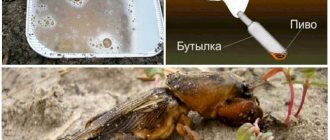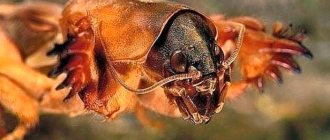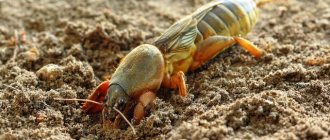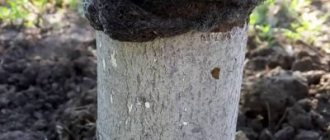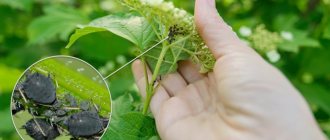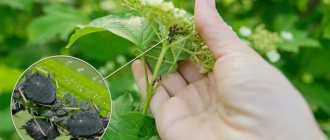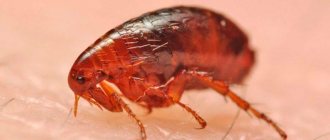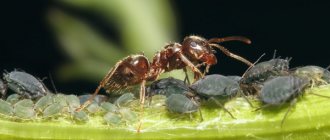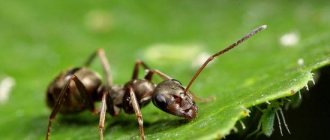The invasion of this pest can only be compared with an invasion of locusts. The mole cricket is an insect that can deprive a garden of crops in a short period of time, not disdaining either the young roots of seedlings or already ripe root crops. Having noticed a voracious pest, gardeners should sound the alarm, because they will not be able to get rid of it quickly. How to get rid of mole crickets in a garden or summer cottage effectively and forever is the topic of today’s article.
Why am I getting rid of the mole cricket?
I always treat garden pest control responsibly. After all, the inattention and carelessness of a gardener often threatens with the death of cultivated plants and the destruction of a significant part of the harvest.
The mole cricket is not the last enemy here. It is also known as cabbage grass, top grass, earthen crayfish, and mole cricket. Based on its body structure and chitinous “shell,” this insect can be confused with a small cancer. The pest sometimes reaches the length of a human palm. But, unlike aquatic inhabitants, it has a pair of wings that allow it to overcome significant distances and water obstacles.
The insect is armed with tentacles and powerful jaws. This “property” makes it unusually voracious - in a season the top can destroy several hectares of plantings. The pest is very prolific - over the summer, two individuals leave numerous offspring, whose number goes into the hundreds.
I do not allow mole crickets to appear on my site for a variety of reasons. The insect gnaws through the root system of various plantings, spoils root crops, and destroys planted seeds. It does not disdain leaves and stems of young plants, and destroys beneficial earthworms.
Distribution and habitat
The habitat where representatives of this type of pest are found covers a very large territory: Western Europe, except for cold countries such as Norway, Asia - Central and Southeast, Transcaucasia and North African countries - Egypt, Morocco, Libya and others. In Russia, the insect is distributed everywhere - from St. Petersburg to Crimea.
The mole cricket does not like hot and dry places, so they live in the part where there is moisture, that is, near reservoirs in sandy or clay soils. The most preferable place for them is a place rich in humus, so very often the insect lives in vegetable gardens, orchards and flower beds. They love wetlands and areas with groundwater.
First, the pest settles in damp and well-manured areas of the garden, and later, if it is not destroyed, it will spread to other areas.
Destruction of mole crickets in the garden
To effectively combat such a serious garden pest, you need to “know it by sight.” I’ll tell you about the life functions of the mole cricket:
- The insect is nocturnal. At this time of day, it gets out to the surface of the earth and changes its location.
- The mole cricket loves warm, moist soil, illuminated by the sun during the day. It prefers a substrate richly fertilized with manure, in which a “greenhouse effect” occurs.
- The insect is unusually prolific. Up to 500 larvae can hatch from one clutch of eggs. In terms of appetite, they can compete with locusts.
The first sign of a pest appearing in the garden is small areas that look like mown grass. The mole cricket cuts it off with its powerful jaws - it fights against shading, which interferes with the breeding of offspring.
signs of a mole cricket in the garden
Carefully monitor the pest operating in your garden - its burrows can be confused with manholes, passages of shrews and moles. But each of these uninvited guests has its own methods of struggle. Traps, bait, erection of natural barriers and the use of ultrasonic repellers are effective against mole crickets. They successfully fight pests using folk remedies.
If these methods are powerless, they turn to chemicals and biological poisons. If the use of such drugs is unsuccessful, “heavy artillery” is needed - a sanitary service specializing in large-scale pest control. Professionals work with powerful chemicals that literally destroy all life on the site. Therefore, turning to such a drastic remedy is justified only in case of a large invasion of earthen crayfish.
Reasons for the appearance and reproduction of the pest
The insect lives on fertile, manured and humus-rich soils, both in garden beds and in greenhouses. Therefore, along with manure or fertile soil brought to the site , summer residents are always in for an unpleasant surprise. Mole crickets are rarely found on dense clay soils.
In nature, the insect lives on wet lands near reservoirs and in floodplains, in abandoned areas and wastelands. It feels at ease in thickets of weeds .
Chemical methods
Chemicals designed to combat garden pests contain potent poisons that are dangerous not only for insects, but also for humans. Therefore, I recommend that you pay attention to the following precautions:
- Carry out the treatment when there are no small children or pets on the site.
- Take care of your own safety: wear thick rubber gloves, closed clothing and shoes, a respirator, a hat and safety glasses.
- Use separate containers and tools for processing. Clean and store these items separately.
- Follow the manufacturer's instructions exactly - do not exceed the dosage.
Chemicals can be divided into two groups:
- Granules: “Phenaxin Plus”, “Thunder”. The products do not require dissolution in water - they are scattered in mole cricket burrows and placed in sweet baits. The insect eats the “delicacy” and dies from the poisons it contains. Granular preparations are highly effective, but very toxic. Eating them by pets, beneficial insects and birds leads to serious poisoning or even death.
- Powders for preparing solutions: “Masterpiece”, “Akara”, “Prestige”. From a spray can or spray bottle, the product is sprayed onto the seeds and root system of seedlings. The drug acts already in the substrate, without harming the harmless terrestrial inhabitants of the garden.
I will present the drugs against mole crickets that are popular in garden centers:
- "Sarin";
- "Antimedvedka";-
- "Boverin";-
- "Medvetox";
- "Grizzly";
- "Frontier";
- "Medvecid";
- "Regent";
- "Rubit Rofakoks";
- "Rembek".
An alternative to chemicals is biologically active drugs. These substances contain spores of pathogenic fungi that are deadly to mole crickets. Once in the insect's body, they begin to actively reproduce. The activity of fungi leads to the subsequent death of the mole cricket.
Natural enemies of mole crickets
Like any other insect, mole crickets become prey to a variety of predators:
- Birds - these can be rooks, starlings, storks, hoopoes or crows.
- Insectivores - hedgehogs, lizards, moles and shrews.
- Arachnids - the wolf spider hunts for grown larvae, it waits until one of them appears not far from its burrow, then it pounces on it and eats it.
- Predatory insects - one of the representatives of this species is the beetle, which lives in Japan and China. The female finds mole cricket burrows and lays eggs there; when larvae emerge from them, they crawl inside and eat the offspring.
- Tailless amphibians - toads perfectly exterminate these agricultural pests.
Ants and ground beetles eat the larvae and destroy the eggs laid by the adults.
Bacteria and parasites also play an important role in the destruction of cabbage mushrooms; they enter their body, which leads to the spread of infection and the death of the insect.
Fungal diseases that attack the insect during winter cold and thaw periods are also dangerous for them. Pathogenic microorganisms can cause the death of an entire population.
Folk ways to get rid of mole crickets
The use of folk remedies against mole crickets has an important advantage - these methods are safe for humans and plants. But they are effective only in the early stages of a pest invasion. If the mole cricket has bred in impressive quantities, it is impossible to do without the use of pesticides.
Kerosene against mole crickets
The old-fashioned way to fight earthen crayfish is to use sand and kerosene. The method is especially good for expelling the pest from the greenhouse.
For 1 m2 of ridge, 1 kg of sand soaked in 50-70 ml of kerosene is required. It is important to thoroughly mix the mass several times: first with the “fragrant” additive, then sand with several shovels of garden substrate. The mixture is recommended for use when planting seedlings and sowing seeds. Holes and furrows are filled with kerosene soil and scattered over the surface of the ridge.
Soapy water
It is possible to get rid of the pest by scouting out the location of its passages. You need to prepare a soap solution, add a little vegetable oil to it (1:10). 1 liter of liquid per mink is enough. An insect, taken by surprise, will hasten to get to the surface. The gardener will only have to destroy it.
I recommend using laundry soap shavings to prepare the solution. Foam from washing powder, shampoo, shower gel, and dishwashing detergent is by no means a useful “fertilizer” for your garden. Such products will saturate the earth with synthetic additives, flavors, and bleaches.
Protective rings
Around individual ridges or greenhouses you can make protective rings - a kind of “right of way” for mole crickets. To do this, ditches and furrows up to 20-50 cm deep are dug. They are covered with crushed eggshells, stove ash, sawdust, broken glass, and brick fragments. To increase efficiency, the contents are filled with kerosene.
Eggshell
You can take advantage of the mole cricket’s gluttony by preparing a “delicacy” for it from spicy crushed eggshells. Pour the shards with aromatic oil - unrefined or homemade. Place the shells in furrows and holes before planting seeds or seedlings.
This product “kills two birds with one stone.” Having eaten sharp fragments, the top will die. And eggshells will serve as a good fertilizer (a source of calcium) for future plantings.
Karbofos
Mole crickets are not averse to eating seeds and grain. Resourceful gardeners prepare the following “treat” for them:
- 1 kg of grain oats, wheat, peas, corn or bran;
- 50 g karbofos;
- 30 g unrefined vegetable oil.
Baits are poured into burrows and insect holes. You can spread them on the surfaces of the beds, but in this case the poison can be eaten by beneficial insects and birds.
If there is a massive invasion of cabbageweeds in the area, it is recommended to water the places where they accumulate with one solution of karbofos. It is important to follow the dosage so as not to destroy all living things in the garden. Carry out the treatment late in the evening, when beneficial insects are already sleeping.
Calcium carbide
Gardeners successfully wage a “chemical war” with mole crickets: they find the pest’s holes and place 5 g of calcium carbide there. Upon contact with groundwater or rainwater, a violent reaction occurs. Acetylene is released, filling all the passages of the mole cricket. With such chemical exposure, the uninvited guest dies.
calcium carbide application in the garden
Traps
When turning to this method of control, be prepared that you will have to manually destroy these impressive insects. Traps are based on the pest's taste preferences. “They know honey” - they love to eat sweet things: honey, sugar syrup, jam.
Let me present a simple way to build a bait:
- Coat the mouth of a glass jar with sticky sweet bait. Pour some syrup inside.
- Dig baits around the perimeter of the site, on the paths. The neck of the container should be level with the ground.
- At night, an insect, attracted by the appetizing smell, will fly in and crawl into the jar, but will stick to the sweet syrup at the bottom and will not be able to rise into the air.
Another bait option is jars filled to the brim with water with the addition of a spoonful of vegetable oil. Once caught in such a trap, the insect will not be able to emerge - the oil creates a film that prevents the flow of air.
The bear also likes beer. A small hole is dug for the trap. A jar or bottle with a wide neck is buried at an angle in one of its vaults. A little beer is poured into the container. The bottom of the hole is watered and the hole is covered with a sheet of iron, plywood or tiles. The insect will have no chance to get out and fly away.
Gardeners take advantage of mole crickets’ addiction to warm manure. During autumn digging, several holes up to 0.5 m deep are made in the area. They are filled with half-rotted horse manure, mullein mixed with straw. The mole cricket will find a cozy haven in the trap. Before the onset of frost, it is enough for the gardener to remove the manure contents from the pits and destroy the pests that have settled in for the winter.
fighting mole crickets with manure
The traps are checked every 5-10 days - the mole crickets they catch are taken out and destroyed. Renew the sweet bait and bury it in a new place. It is enough to place the traps at a distance of 4-5 m from each other.
Favorite plants
It is difficult to name crops that the mole cricket does not like. She loves to chew on everything that gets in her way. A list of the most popular can be seen below.
New potatoes
The mole cricket loves young potatoes, as their tubers contain a lot of moisture. They are easier to chew and appear in gardens quite early, when there is no other crop yet.
Fodder and sugar beets
This vegetable also attracts cabbageweed. The insect loves sugar. There is a lot of it in fodder and sugar beets, so it eats these vegetables with pleasure.
Carrot
Sweet carrots can also be damaged by mole crickets. At the same time, the tops remain untouched and it is difficult to guess the problem from the outside. However, the carrots themselves are half eaten from the inside or up to the tops.
White cabbage
This vegetable suffers from the invasion of cabbage grass, as it damages its root system. This insect is especially dangerous for seedlings, which can be completely destroyed.
Tomatoes and eggplants
Cabbage grass is also dangerous for nightshade plantings. Having multiplied in the area, the beetle can destroy tomatoes. He feasts not only on the root system, but also on the fruits that are on the ground. Eggplants also fall prey to this insect.
bell pepper
A mole cricket can even live in a greenhouse. The underground part of the bell pepper suffers from its activity. As a result, the plant will wither and die.
Pumpkin
Mole cricket can cause serious damage to plants belonging to this family, such as pumpkin, watermelon, melon, and cucumber. It gnaws through their root system and stems.
Strawberries
Sweet strawberries attract cabbage grass. This beetle also harms the underground part of the plant.
Ultrasonic repellers
A modern universal way to combat garden pests is ultrasonic repellers. These products will save your area not only from mole crickets, but also from moles, rats, and shrews. The device emits signals that are not audible to the human ear, but are completely intolerable to pests. The constant broadcast of unpleasant sounds forces mole crickets to leave your area.
However, gardeners have ambivalent assessments of such means. It is enough to turn off the device, and the area again becomes defenseless against pests. Moreover, some insects “get used” to ultrasound, and it ceases to be an obstacle to crop destruction.
ultrasonic repellers against garden pests
Harm and danger of the mole cricket
The pest poses a threat to cultivated plants. Fighting mole crickets in the garden using folk remedies will help:
- Increase productivity.
- Do not disturb the ecological situation.
- Maintain green spaces in proper biological condition.
The harm caused by mole crickets is:
- principles of nutrition;
- insect diet;
- life cycle;
- the nature of the actions;
- anatomical structure of the body.
Digging winding passages and building underground nests leads to wilting and diseases of cultivated plants.
On a note! The mole cricket poses the greatest threat to young shoots. The pest gnaws the deep part of plants, while feeding on the ground.
Favorite delicacies of the mole cricket:
- onion;
- cabbage;
- carrot;
- cucumbers;
- tomatoes;
- eggplant;
- salad.
Insect larvae actively spoil root crops. Potatoes often suffer from the activity of garden pests.
The best means of combating mole crickets
Preventing the appearance of mole crickets
In order not to waste time on energy-consuming fight against crayfish, I recommend paying attention to simple but effective means of preventing the appearance of the pest:
- Careful autumn soil cultivation (digging, loosening). During this procedure, the pest eggs are forced to the surface of the earth and destroyed. The insect rarely returns to the area where its passages and usual living conditions have been destroyed - it flies away to look for a more favorable place.
- Construction of natural barriers along the perimeter of the site. The pest will not be able to “break through” the developed root system of shrubs and trees. The pest especially does not like bird cherry and alder. If you do not have the opportunity to plant these trees, make stakes from their branches without stripping the bark. Stick the sticks to a depth of 20-30 cm, change them as they dry out.
- Planting garden flowers. Mole crickets cannot tolerate marigolds, chrysanthemums and calendula. Such a “green shield” can be planted along the borders of the ridges that are loved by the uninvited guest.
- Iodine opposition. Before sowing the seeds of parsley, carrots and other root vegetables, the furrows are shed with iodine solution: 20 drops per 10 liters of water.
- Onion and garlic. The mole cricket is repelled by the smell of onion infusion and mashed heads of garlic.
- Odor protection. The pest does not like the strong “aroma” of naphthalene and kerosene. These products are used to “flavor” the sand and scatter it around the perimeter of the garden. A rather radical method is to bury pieces of rotten fish in the ridges favored by mole crickets.
- Coniferous barriers. They also cannot tolerate the aroma of pine needles. Place fresh branches of spruce, pine, fir near the beds, change them as they dry out.
- Use of sound effects. Hang rattles, bells, bells, windmills, and pieces of magnetic tape around the perimeter of the site. The sounds they make repel pests.
- Attracting natural enemies. Birds include starlings, crows, storks, and rooks. Insectivorous animals include scolopendras, shrews, hedgehogs, ground beetles, and lizards.
The mole cricket is a rather dangerous enemy of the gardener. This is a prolific, voracious large insect with chitinous “durable” armor.
It digs out long underground passages and flies over impressive distances. To avoid encountering it on your site, do not forget about preventive measures. If the mole cricket has already settled in your garden, do not hesitate to destroy it. Otherwise, the uninvited guest will easily leave you without the long-awaited harvest.
What an insect looks like - photo and description
The mole cricket happily lives in the garden and greenhouses. She has plenty of food there; she can be found on the lawn and flower beds. However, she lives underground. The insect is called Gryllotalpa gryllotalpa in Latin.
This is interesting! The Latin name Gryllotalpa is formed from two words meaning cricket (Gryllus) and mole (Talpa). It perfectly reflects the unusual appearance of the pest!
The mole cricket looks a bit like a cricket. It makes a sound similar to the singing of crickets - a loud, distinct clicking sound. The sound can be heard from May to June, when adults make a characteristic “chirp” in the evenings. This sound is often confused with the sound of a cricket.
Musicians are males who “sing” thanks to the stridulation apparatus, that is, the organ through which sounds are made. Crickets and other insects, arachnids and crustaceans are equipped with a similar apparatus. The males dig out a special chamber that acts like a concert hall and is built to have better acoustics - thanks to this, the “song” is perfectly audible even on the surface. The melody can be heard on warm spring evenings, it sounds completely different from the sounds of crickets. Listen for yourself.
The mole cricket has a length of 5-7 cm, sometimes grows up to 10 cm. The body is gray or brown. The elongated shape makes it easier for the insect to squeeze between clods of earth.
Although the insect has a pair of wings, it does not fly. The first pair of wings is leathery, the second is membranous. The head and forearms are covered with small dense hairs. The pest has 2 characteristic “spikes” on its stomach; these are not “weapons”, but special appendages that act as a parking sensor in a car. The spines allow the insect to move by moving backwards. In the underground corridors there is no room to turn and the insect has to return backwards.
Mouthparts are biting type. The jaws are not very impressive in size, but are strong enough to do their job - bite into hard tubers and roots. When an insect senses danger, it can defend itself with its jaws and bite its attacker. It can bite through human skin, which is not too dangerous for our health, provided that timely vaccinations against tetanus are received.
The front legs are of the rowing type (resemble shovels), the rest are of the running type. The forelimbs are long, ending in blade-shaped protrusions, similar to miniature paws of a mole, used for digging underground corridors and raking the earth.
The insect's mating season occurs in May. During this period you can see them in the garden, then they come to the surface longer. In June, females lay eggs, from which larvae hatch after 4 weeks. Eggs are laid in the soil to a depth of 30 cm in specially built chambers. The eggs are oval, brightly colored, the size of a mustard seed. Each female lays up to 300 eggs! Therefore, the pest population can increase rapidly. After about 21 days, the larvae hatch.
Before hatching and during the early larval period, the female remains nearby, protecting the young generation from predators. Under her care, the larvae feed in the immediate vicinity of the nest. Most larvae will not survive the first year. Adults and larvae overwinter, buried in the soil at a depth of 60-80 cm. In the spring (from April), the insect wakes up and migrates to the upper layers of the soil and resumes feeding. In May, adult insects look for pairs and copulate.
The length of the larvae is several centimeters, the body is white or cream.
Young larvae are small (resemble large whitish ants), later they begin to resemble adults. Initially the larvae are wingless, only the oldest have wings. Mole cricket larvae feed on plants in a summer cottage, so they are also harmful, and control of the larvae is necessary.
Photo. Young mole cricket larva
An adult lives 2-4 years, usually stays in the soil, and comes to the surface mainly at night.
What kind of life does a mole cricket lead?
For living, the mole cricket chooses moist areas of loose soil with rotted organic matter. The presence of manure in the soil attracts the mole cricket, and a quiet place underground with high humidity is an ideal habitat for the insect. These are the conditions that people create when they plow the soil in the spring and plant seedlings.
Mole cricket burrows
Mole crickets overwinter underground, at a depth of 25-30 cm, “hibernating”. In spring, when the soil warms up to + 15°C, insects rise higher and carry out activities at a depth of 5-10 cm, sometimes rising to the very surface. At the end of May and beginning of June, when the ground warms up to the required temperature, the mole cricket lays eggs in a specially equipped den. It is equipped in a quiet, secluded place at a depth of about 10 cm. The insect surrounds the space under the surface of the earth around the “cradle” with communicating passages, in several places emerging to the surface in the form of vertical burrows. By opening and closing one or another entrance to the system, the kapustyanka provides the necessary ventilation and temperature in the den.
You can locate the egg laying site by looking at a small area of trimmed grass located among several small holes. This is how the insect takes care of its offspring, removing the shadow over the masonry and ensuring it is warmed by the sun's rays. The mole cricket larva matures within a year.
Mole cricket egg laying
It is difficult to see the mole cricket itself during the day, since it is predominantly nocturnal. The insect moves very quickly across the surface. In case of danger, it burrows into the ground very quickly.
